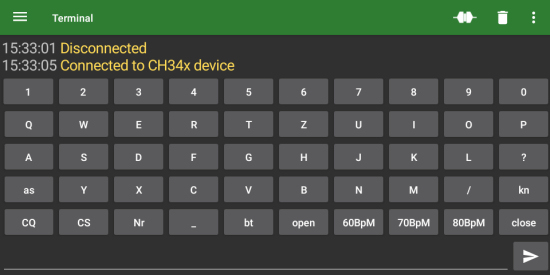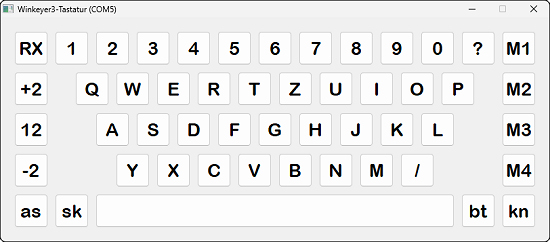The K1EL WKmini nano UK is controlled via USB interface with 1200 baud, 8 bits, no parity and 2 stop bits.
It is advisable to familiarize yourself with the features of the Winkeyer and to test the communication before use.
For this purpose, the program "WK3tools" is available at K1EL Systems under the "Software" page.
The field designations given there correspond to the bits of the control registers to be set later by the computer.
After determining the port number ("Set Com Port") and opening the connection ("Test WK"), the parameters can be queried with "Read WK" and set with "Write WK".
"MinWpm" and "MaxWpm" specify the setting limits of the speed potentiometer.
Although this is not present here, any values emitted by the machine outside the range boundaries are ignored.
With "CurWpm", the initial value of the scanning speed can be specified.
This is also used in stand-alone operation.
If you have selected "Port1, ST" under "Output Selection", the Morse code at the tip of the 3.5 mm stereo jack plug will be output to ground and a listening tone (ST for "Sidetone").
If "PdToneOnly" is activated, then a sidetone can be heard when the paddle is used, but not when characters are output by the computer.
If the sidetone tone emitted by the transceiver when keying is sufficient anyway, set "Output Selection" to "Port1".
The function of the paddles changes when "Swap" is activated.
If "AutoSpace" is activated, a letter spacing (3 point lengths pause) is always inserted if the gap between the key presses is too short.
These and other settings are of course also possible from the computer, more on that below.
The complete list of Winkeyer3 commands including the corresponding parameters can be found on the above website under "ICs" under "Winkeyer3" in "Winkeyer3 Datasheet".
It should be noted that not all commands have an effect on the slimmed-down version of the Winkeyer.
Used control commands 
[00] [nn] "Admin Command"
[nn] = 0x00 für Host Open
[nn] = 0x03 für Host Close
[0E] [nn] "Set WinKeyer Mode"
[nn] = 0x12 composed of
Bit 8 = 0 for Disable Paddle watchdog
Bit 7 = 0 for Paddle Echoback Disabled
Bit 6/5 = 01 for Iambic A
Bit 4 = 0 for Paddle Swap Normal
Bit 3 = 0 for Serial Echoback Disabled
Bit 2 = 1 for Autospace Enabled
Bit 1 = 0 for CT Spacing Normal Wordspace
[09] [nn] "Set PinConfig"
[nn] = 0x0C composed of
Bit 7/8 = 00 for Ultimatic Priority Normal
Bit 5/6 = 00 for Hang Time
Bit 4 = 1 for KeyOut1 Enable
Bit 3 = 1 for KeyOut2 Enable
Bit 2 = 0 for Sidetone Disable
Bit 1 = 0 for PTT Disable
[02] [nn] "Set WPM Speed"
[nn] = 0x0C for 6 WPM
[nn] = 0x0E for 7 WPM
[nn] = 0x10 for 8 WPM
[nn] = 0x12 for 9 WPM
[nn] = 0x14 for 10 WPM
Android App 
 The USB Serial Terminal app by Kai Morich, a terminal program for devices that can be controlled via the USB interface, is suitable for control with an Android smartphone.
The app can be used in a row-oriented manner, but also allows you to display 5 rows of 10 macro buttons each.
The USB Serial Terminal app by Kai Morich, a terminal program for devices that can be controlled via the USB interface, is suitable for control with an Android smartphone.
The app can be used in a row-oriented manner, but also allows you to display 5 rows of 10 macro buttons each.
That′s more than enough for 26 letters, 10 digits, and some special characters. With 2 buttons to open and close the connection, 3 to adjust the scanning speed, there was still room for 3 text memories.
After pressing a button for a long time, a window opens in which you enter the label of the button and the macro to be output.
In "Edit Mode", "Text" must be activated for ASCII characters and "Hex" for hex values.
A finished file is available here.
After unzipping, it can be loaded into the smartphone's download folder, imported via "Configuration" and then modified.
Windows touch program 
 As an alternative, I wrote a small control program with a touch keyboard for a tablet PC.
I used PureBasic as a programming language.
This has the advantage that COM interfaces can be controlled directly from the program.
And you can create executable programs for Windows, Linux, and OS X.
The free version has a limit of about 800 lines, but this is enough to compile the source code.
As an alternative, I wrote a small control program with a touch keyboard for a tablet PC.
I used PureBasic as a programming language.
This has the advantage that COM interfaces can be controlled directly from the program.
And you can create executable programs for Windows, Linux, and OS X.
The free version has a limit of about 800 lines, but this is enough to compile the source code.
The implemented functions are similar to those of the Android app described above.
The scanning speed can be adjusted more flexibly via the "+2" and "-2" buttons by 2 WpM (words per minute) in the range of 8 WpM to 30 WpM.
The button in between shows the currently set speed.
Its actuation sets the initial speed to 12 WpM.
The "RX" button clears the input buffer of the Winkeyer and ends any output that may still be running.
The contents of the 4 text memory buttons can be specified via the initialization file.
If this file is missing, it is created and filled with dummy texts matching the buttons (M1, M2, M3, M4).
Instead of these placeholders, you can enter 4 new lines with ASCII characters with any text editor.
The EXE program created for Windows (64 bit), the source code and the INI file are available here.